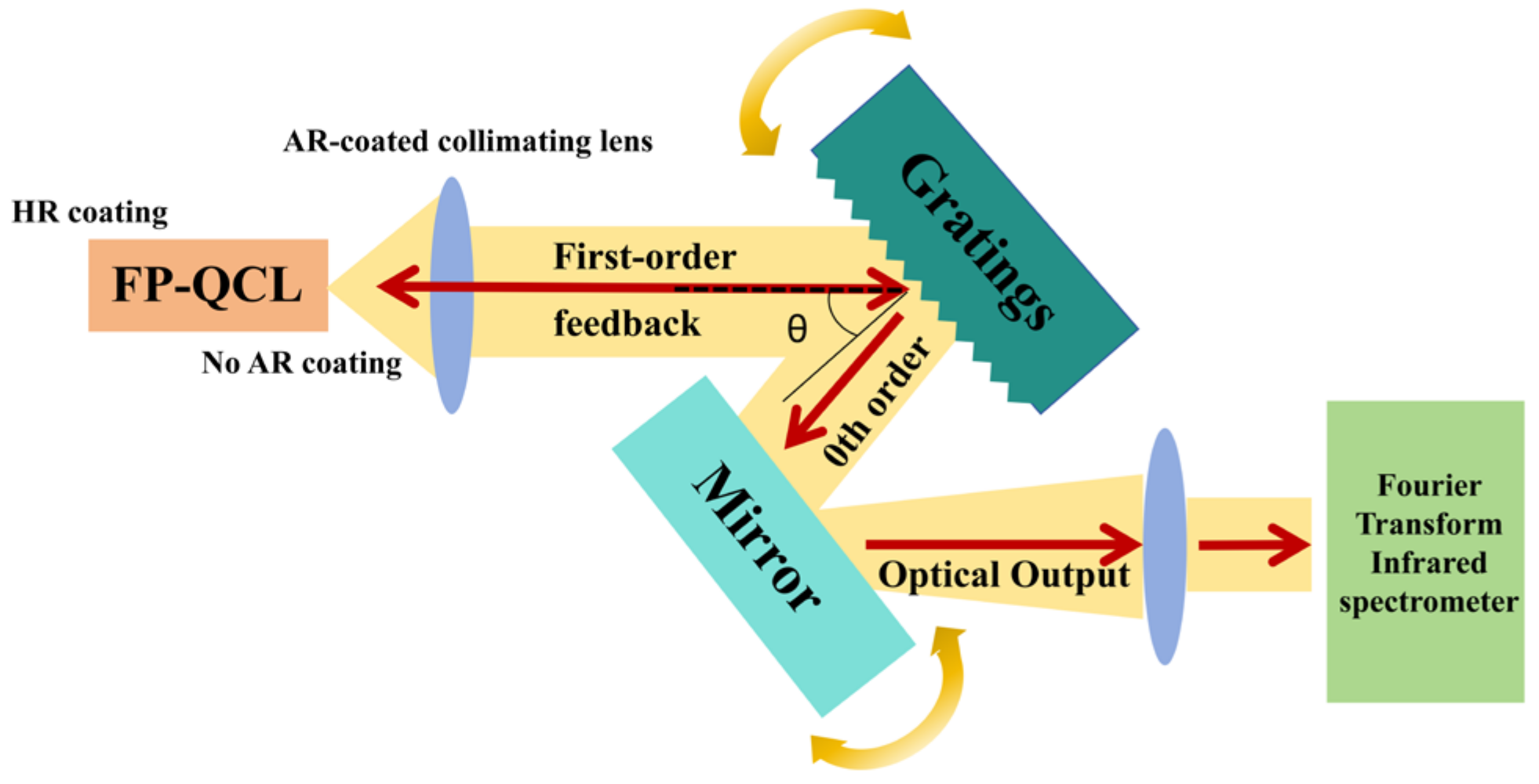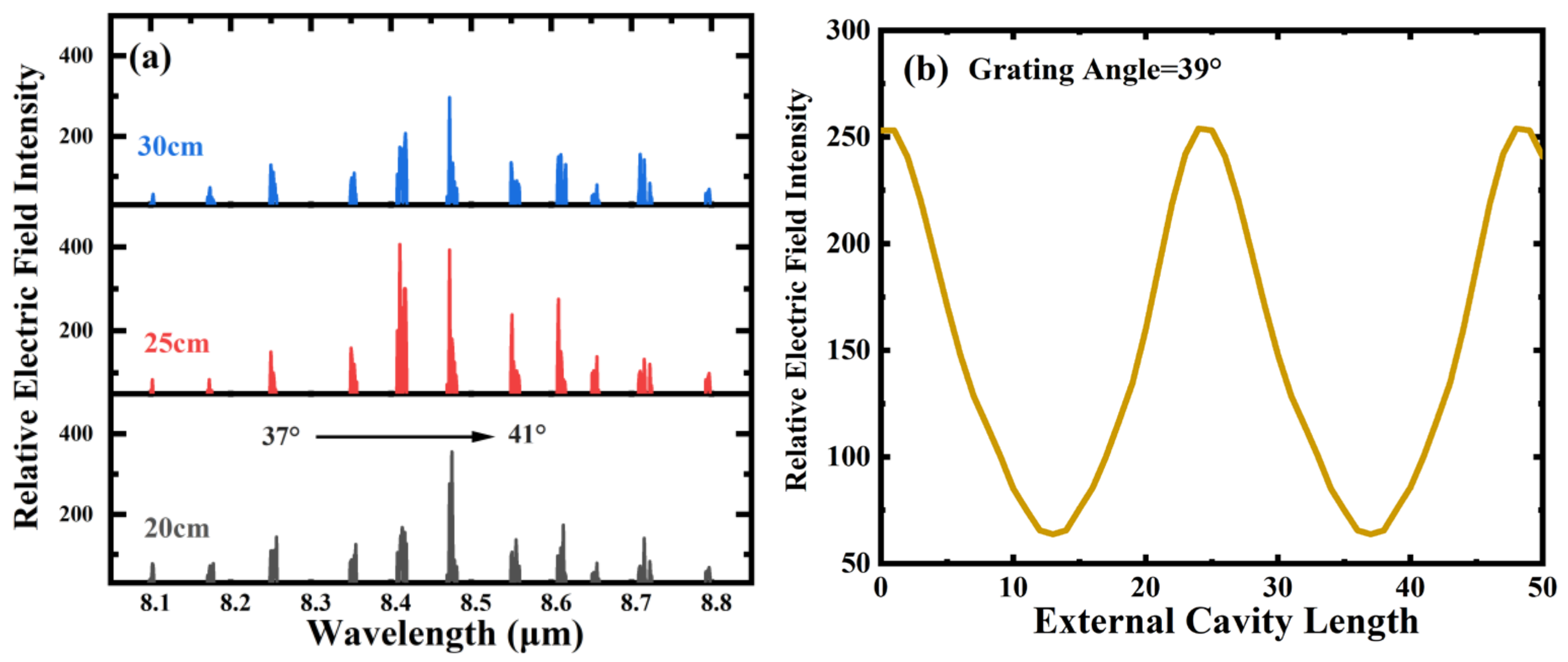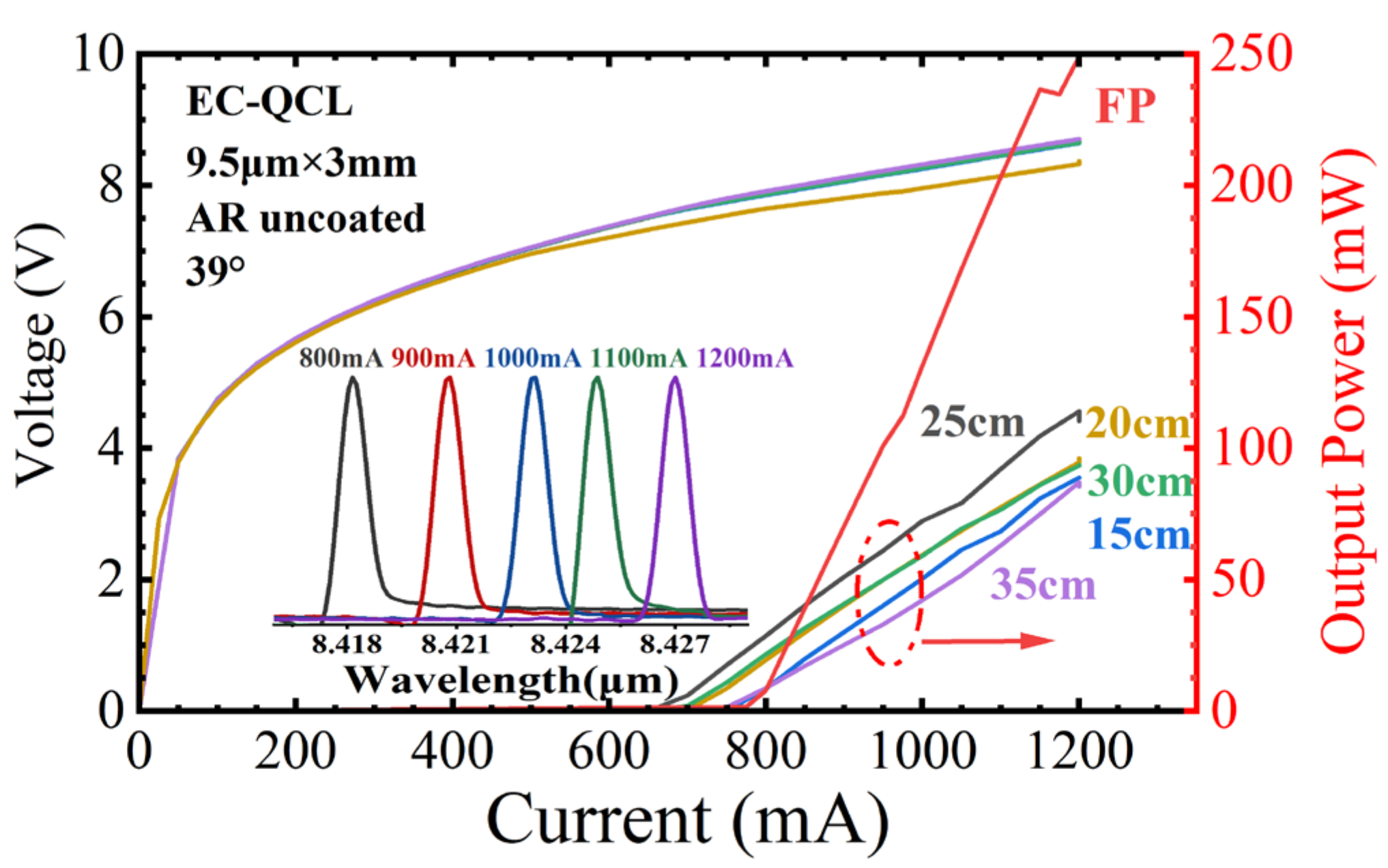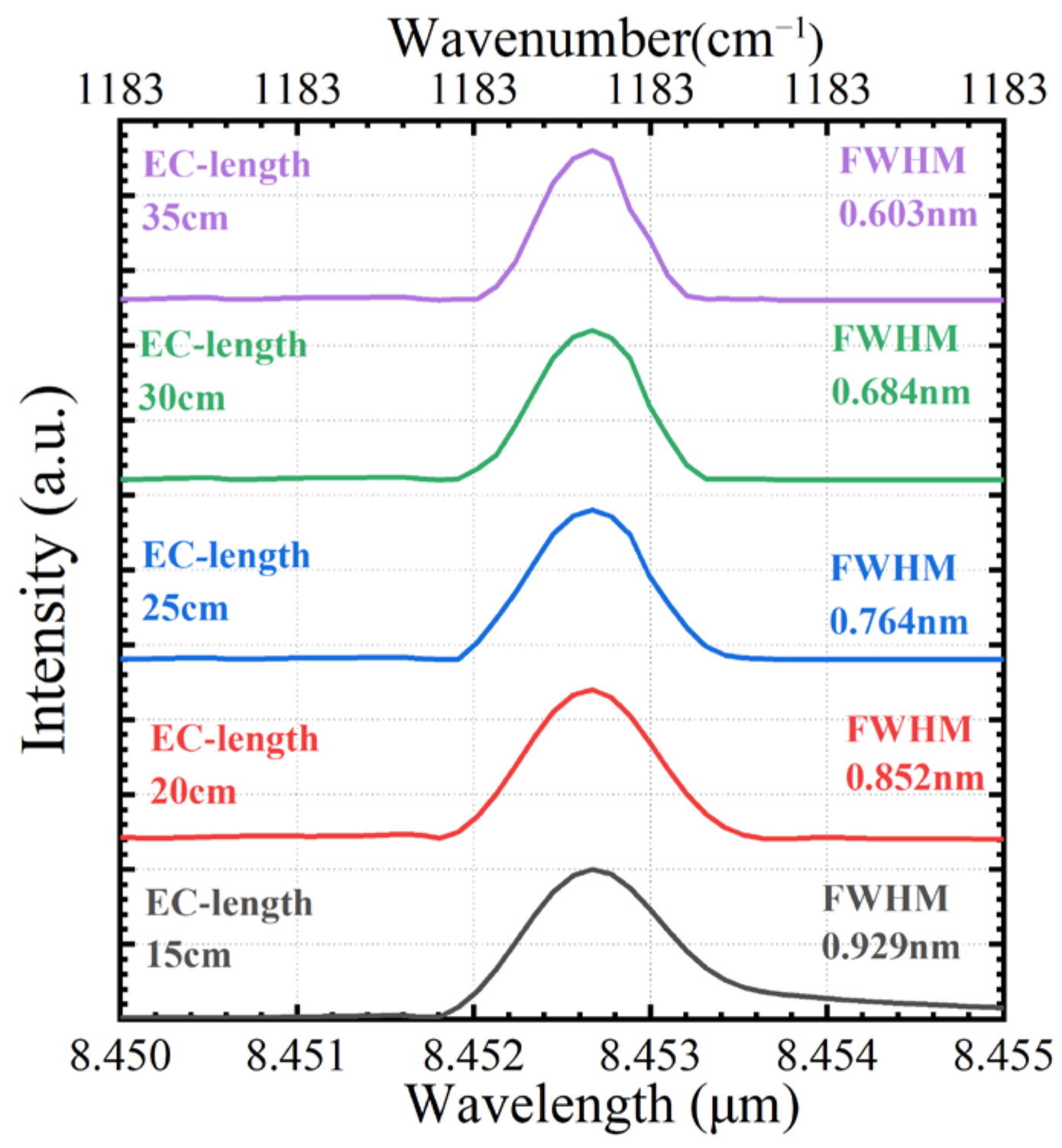Continuous-Wave Room-Temperature External Cavity Quantum Cascade Lasers Operating at λ~8.5 μm
Abstract
1. Introduction
2. External Cavity Setup
3. Result and Analysis
3.1. Effect of External Cavity Length
3.2. Effect of Injection Current
3.3. Effect of Temperature
4. Conclusions
Author Contributions
Funding
Institutional Review Board Statement
Informed Consent Statement
Data Availability Statement
Conflicts of Interest
References
- Wysocki, G.; Curl, R.F.; Tittel, F.K.; Maulini, R.; Bulliardand, J.M.; Faist, J. Widely tunable mode-hop free external cavity quantum cascade laser for high resolution spectroscopic applications. Appl. Phys. B 2005, 81, 769–777. [Google Scholar] [CrossRef]
- Curl, R.F.; Capasso, F.; Gmachl, C.; Kosterev, A.A.; McManus, B.; Lewicki, R.; Pusharsky, M.; Wysocki, G.; Tittel, F.K. Quantum cascade lasers in chemical physics. Chem. Phys. Lett. 2010, 487, 1–18. [Google Scholar] [CrossRef]
- Basistyy, R.; Genoud, A.; Diaz, A.; Moshary, F.; Thomas, B. Active standoff mixing-ratio measurements of N2O from topographic targets using an open-path quantum cascade laser system. In Proceedings of the SPIE Conference on Lidar Remote Sensing for Environmental Monitoring, Honolulu, HI, USA, 24–25 September 2018; Volume 10779, pp. 73–82. [Google Scholar]
- Totschnig, G.; Winter, F.; Pustogov, V.; Faist, J.; Müller, A. Mid-infrared external-cavity quantum-cascade laser. Opt. Lett. 2002, 27, 1788–1790. [Google Scholar] [CrossRef]
- Hugi, A.; Maulini, R.; Faist, J. External cavity quantum cascade laser. Semi. Sci. Technol. 2010, 25, 083001. [Google Scholar] [CrossRef]
- Mohan, A.; Wittmann, A.; Hugi, A.; Blaser, S.; Giovannini, M.; Faist, J. Room-temperature continuous-wave operation of an external-cavity quantum cascade laser. Opt. Lett. 2007, 32, 2792–2794. [Google Scholar] [CrossRef] [PubMed]
- Hugger, S.; Fuchs, F.; Jarvis, J.; Kinzer, M.; Yang, Q.K.; Driad, R.; Aidam, R.; Wagner, J. Broadband-tunable external-cavity quantum cascade lasers for the spectroscopic detection of hazardous substances. In Proceedings of the SPIE Quantum Sensing and Nanophotonic Devices X, San Francisco, CA, USA, 3–7 February 2013; Volume 8613, pp. 512–524. [Google Scholar]
- Tan, S.; Zhang, J.C.; Zhuo, N.; Wang, L.J.; Liu, F.Q.; Yao, D.Y.; Liu, J.Q.; Wang, Z.G. Low-threshold, high SMSR tunable external cavity quantum cascade laser around 4.7 μm. Opt. Quantum Electron. 2013, 45, 1147–1155. [Google Scholar] [CrossRef]
- Hugi, A.; Terazzi, R.; Bonetti, Y.; Wittmann, A.; Fischer, M.; Beck, M.; Faist, J.; Gini, E. External cavity quantum cascade laser tunable from 7.6 to 11.4 μm. Appl. Phys. Lett. 2009, 95, 1083–1088. [Google Scholar] [CrossRef]
- Maulini, R.; Mohan, A.; Giovannini, M.; Faist, J.; Gini, E. External cavity quantum-cascade laser tunable from 8.2 to 10.4 µm using an inhomogenously broadened gain element. Appl. Phys. Lett. 2006, 88, 20. [Google Scholar] [CrossRef]
- Zhao, Z.B.; Wang, L.J.; Jia, Z.W.; Zhang, J.C.; Liu, F.Q.; Zhuo, N.; Zhai, S.Q.; Liu, J.Q.; Wang, Z.G. Low-threshold external-cavity quantum cascade laser around 7.2 μm. Opt. Eng. 2016, 55, 046116. [Google Scholar] [CrossRef]
- Matsuoka, Y.; Peters, S.; Semtsiv, M.P.; Masselink, W.T. External-cavity quantum cascade laser using intra-cavity out-coupling. Opt. Lett. 2018, 43, 3726–3729. [Google Scholar] [CrossRef] [PubMed]
- Deng, J.L.; Dong, J.J.; Gao, M.G.; Li, X.X.; Li, Y.; Han, X.; Liu, W.Q. Improved Triangular Window Apodization Function Based on Zero-Order Bessel Function. Acta Opt. Sin. 2020, 40, 8. [Google Scholar]
- Coldren, L. Mirrors and resonators for diode lasers. In Diode Lasers and Photonic Integrated Circuits; John Wiley & Sons: Hoboken, NJ, USA, 1995; pp. 65–110. [Google Scholar]
- Slivken, S.; Evans, A.; Yu, J.S.; Darvish, S.R.; Razeghi, M. High power, continuous-wave, quantum cascade lasers for MWIR and LWIR applications. In Proceedings of the SPIE Quantum Sensing and Nanophotonic Devices III, San Jose, CA, USA, 23–26 January 2006; Volume 6127, pp. 15–24. [Google Scholar]
- Osmundsen, J.; Gade, N. Influence of optical feedback on laser frequency spectrum and threshold conditions. IEEE J. Quantum Electron. 1983, 19, 465–469. [Google Scholar] [CrossRef]
- Lu, Q.Y.; Slivken, S.; Wu, D.H.; Razeghi, M. High power continuous wave operation of single mode quantum cascade lasers up to 5 W spanning λ~3.8–8.3 µm. Opt. Express 2020, 28, 15181–15188. [Google Scholar] [CrossRef] [PubMed]
- Schundelmeier, J.; Yang, Q.; Hugger, S. Hysteresis behavior of external cavity Quantum Cascade Lasers in the strong feedback regime. IEEE J. Quantum Electron. 2024, 60, 2. [Google Scholar] [CrossRef]
- Yu, J.S.; Slivken, S.; Evans, A.; Darvish, S.R.; Nguyen, J.; Razeghi, M. High-power λ~9.5 μm quantum-cascade lasers operating above room temperature in continuous-wave mode. Appl. Phys. Lett. 2006, 88, 9. [Google Scholar]
- Kim, T.; Ogura, M. High characteristic temperature (T0 = 322 K near room temperature) of V-grooved AlGaAs-GaAs quantum wire diode lasers. Solid-State Electron. 2000, 44, 185–187. [Google Scholar] [CrossRef]







Disclaimer/Publisher’s Note: The statements, opinions and data contained in all publications are solely those of the individual author(s) and contributor(s) and not of MDPI and/or the editor(s). MDPI and/or the editor(s) disclaim responsibility for any injury to people or property resulting from any ideas, methods, instructions or products referred to in the content. |
© 2025 by the authors. Licensee MDPI, Basel, Switzerland. This article is an open access article distributed under the terms and conditions of the Creative Commons Attribution (CC BY) license (https://creativecommons.org/licenses/by/4.0/).
Share and Cite
Wang, Z.; Lin, Y.; Ma, Y.; Wan, C.; Dong, F.; Zhou, X.; Zhang, J.; Liu, F.; Zheng, W. Continuous-Wave Room-Temperature External Cavity Quantum Cascade Lasers Operating at λ~8.5 μm. Photonics 2025, 12, 129. https://doi.org/10.3390/photonics12020129
Wang Z, Lin Y, Ma Y, Wan C, Dong F, Zhou X, Zhang J, Liu F, Zheng W. Continuous-Wave Room-Temperature External Cavity Quantum Cascade Lasers Operating at λ~8.5 μm. Photonics. 2025; 12(2):129. https://doi.org/10.3390/photonics12020129
Chicago/Turabian StyleWang, Zixian, Yuzhe Lin, Yuan Ma, Chenyang Wan, Fengxin Dong, Xuyan Zhou, Jinchuan Zhang, Fengqi Liu, and Wanhua Zheng. 2025. "Continuous-Wave Room-Temperature External Cavity Quantum Cascade Lasers Operating at λ~8.5 μm" Photonics 12, no. 2: 129. https://doi.org/10.3390/photonics12020129
APA StyleWang, Z., Lin, Y., Ma, Y., Wan, C., Dong, F., Zhou, X., Zhang, J., Liu, F., & Zheng, W. (2025). Continuous-Wave Room-Temperature External Cavity Quantum Cascade Lasers Operating at λ~8.5 μm. Photonics, 12(2), 129. https://doi.org/10.3390/photonics12020129




